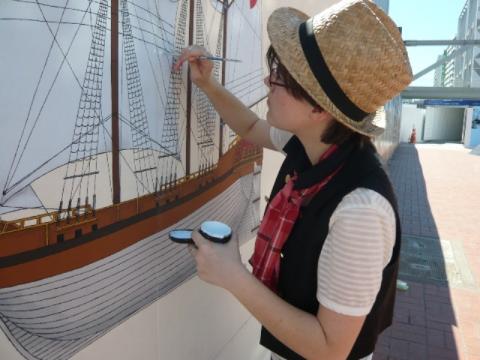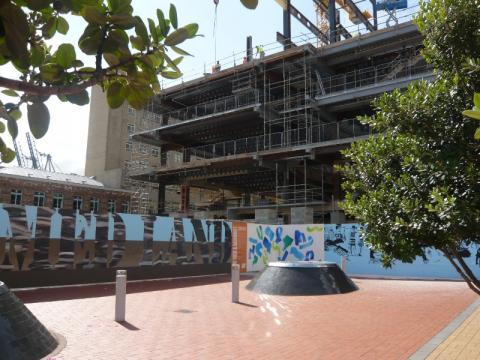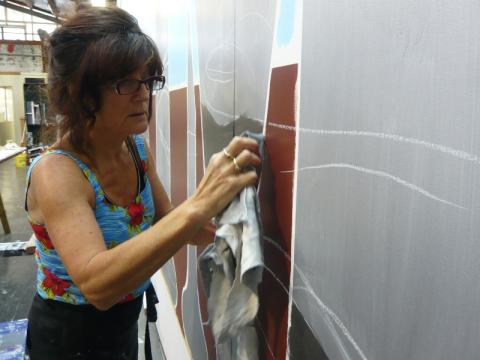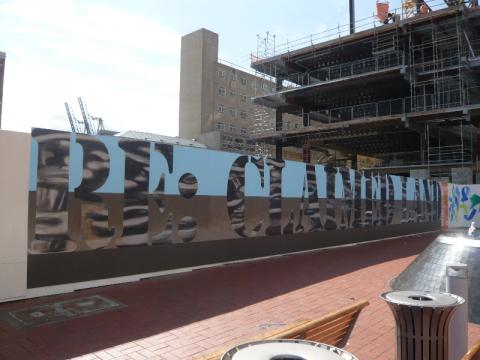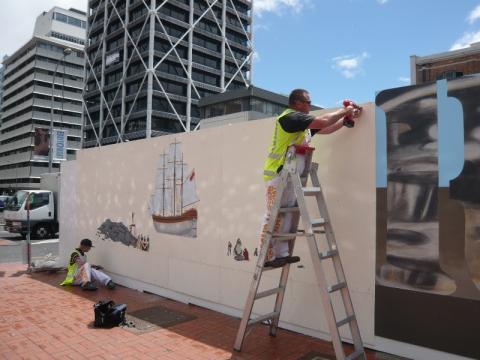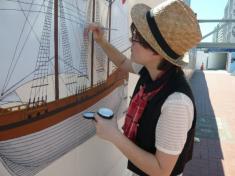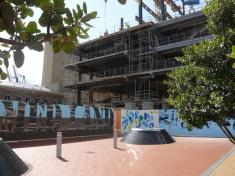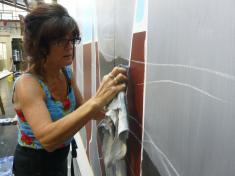Bare Rock & Backbones
Emerging artists public art project
In 1840, there was sea water at Britomart. Waka (canoes) were launched from tidal mudflats, and a prominent headland stretched out into the harbour near the site of this painting exhibition by selected emerging artists. There was a Maori pa (fort) on the headland. A colonial military fort was then built, which later became an orphanage, before being torn down as the headland itself was demolished to fill in the bay. Auckland’s first colonial settlers arrived here, lifting their belongings and their skirts or coats above the mud. From this shore they surveyed their new home, and planned new lives and a new city. The 40 years that followed their arrival was a period of massive cultural and environmental change.
We invited four emerging artists to find something that was of interest to them in the stories of Britomart’s early history, and asked them each to make a new artwork. The four paintings are the first in a series of exhibitions by emerging artists that will be installed in an outdoor exhibition at Britomart. The exhibition title, Bare Rock & Backbones, refers to the sheer determination of the people of this place in forging the fledgling city from rock and mud.
Bare Rock & Backbones was commissioned by Cooper and Company, who own and manage the Britomart site, and developed by Rob Garrett Contemporary Fine Art Ltd.
Aleksandra Petrovic
Untitled
Between 1865 and 1867, the former fort at Britomart was home to the city’s orphans – not much else is known about this period. Aleksandra Petrovic likes to focus on ‘small stories’ about people who would otherwise be forgotten. Petrovic is interested in how history is rewritten in its retelling. She puts several scenes together in her work so the viewer can make stories from them. Her figures are engaged in activities with items used in the documentation of history, such as plans, maps and diaries. Born in 1985, Petrovic graduated with a Bachelor of Fine Arts from Elam School of Fine Arts, University of Auckland, in 2007.
Karena Way
Lodgement
Karena Way is interested in the idea that the Britomart site is reclaimed land. The word ‘lodgement’ refers to making a claim, or establishing a foothold in another’s territory. Way’s work invites us to think about the many possible plays on the words 'reclaimed land.’ 'Reclaimed land' describes the physical movement of the earth of Point Britomart into the foreshore and seabed to create a larger landmass for settlement and trade. ‘Reclaimed land’ also describes the reclaiming and renaming of the country and land by different parties: the Dutch, who called Aotearoa ‘Nova Zeelandia’, and then the British, who reclaimed/renamed it again – ‘New Zealand/Niue Tirini’. Way’s artwork uses the visual style of advertising and political posters. The ‘stencil’ font she has used re-emphasises the site as a place of transition; a place where baggage, goods and documents are stamped. Historically this ‘stencil’ font refers to shipping, travel, cargo and passage. Way recently completed studies towards a Masters Degree in Fine Arts at Elam School of Fine Arts, University of Auckland
Ann Quickenden
Tribute to the Sea
Ann Quickenden’s painting focuses on water’s energy and the way it flows to bring and sustain life.
Tribute to the Sea
recalls the extensive seascape that was here before Britomart was reclaimed to form wharves and commercial land. Auckland’s foreshore once ran along Fort Street, formerly known as Fore Street, two blocks inshore from here. Quickenden is a recent Bachelor of Fine Arts Honours graduate from Elam School of Fine Arts at the University of Auckland. Her recent public art works include
Opulence
an installation in Auckland Starship Hospital’s Ronald McDonald House (2007), billboards and projections in the Auckland CBD (2008), and a large LED screen moving image on Wellington’s Embassy Theatre (2008)
Matt Dowman
Integrate Globally Disintegrate
Locally Matt Dowman’s work focuses on the effects and ramifications of the tumultuous cultural changes at Britomart between 1840 and 1890. Imagery of indigenous wildlife, ships, colonials and Maori represents elements that have been altered or affected in some way through processes of cultural and environmental assimilation. Parts of the post office building (now Britomart train station) represent the impact of industry on the environment. Dowman graduated with Honours from the Masters of Fine Arts programme at Elam School of Fine Arts in 2004, having previously completed his Bachelor’s Degree at Whitecliffe College of Art and Design. He has won numerous scholarships and in 2008 was runner-up in the New Zealand Painting and Printmaking Award. Dowman currently tutors at Whitecliffe College of Art and Design. He is represented by Vavasour Godkin Gallery.
Artists (exhibition #1) : Aleksandra Petrovic, Karena Way, Ann Quickenden, Matt Dowman
Title: Bare Rock & Backbones (each artist’s work is titled individually; see profiles above)
Date: November 2008-March 2009 (ongoing)
Media: Acrylic paint on board
Dimensions: 70 x 2.2 metres
Commissioner: Cooper and Company
Curator: Rob Garrett
Project art management: Rob Garrett
Sponsors: Ernst & Young, Hawkins Construction and Resene
Location: Takutai Square, Britomart, Auckland CBD, New Zealand
Duration: Approximately 2 years (from November 2008)
Links:
